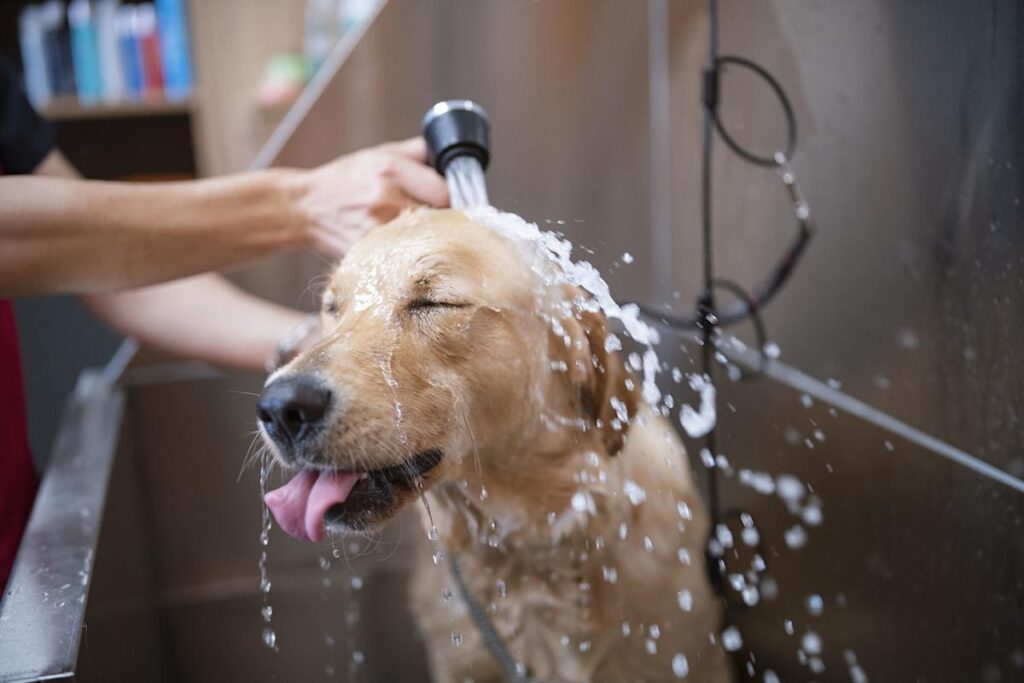Understanding the appropriate bathing schedule for your dog is crucial for their overall health and well-being.
A “dog washing frequency chart” can serve as a helpful tool to determine how often your furry friend should be bathed based on factors like breed, coat type, and activity level.
According to the American Kennel Club, the frequency of dog baths varies depending on several factors, including coat length and texture, skin health, and activity level.
For example, dogs with short, smooth coats may require baths every one to three months, while those with long, dense coats may need more frequent washing.
Additionally, dogs with oily coats or skin allergies might benefit from more regular baths.
It’s important to note that overbathing can strip natural oils from your dog’s skin and coat, leading to dryness and irritation.
Conversely, infrequent bathing can result in dirt, oils, and odors buildup. Therefore, finding the right balance is essential.
Factors Influencing Dog Washing Frequency
According to the Journal of the American Veterinary Medical Association, below are the factors influencing dog washing frequency:
1. Coat Type and Length
Dogs with long or dense coats, such as Golden Retrievers or Siberian Huskies, may require more frequent baths to prevent matting and to remove dirt and debris. Short-haired breeds like Beagles or Chihuahuas typically need less frequent bathing.
Learn more about the low electrolytes treatment in dogs here.
2. Activity Level
Active dogs that spend a lot of time outdoors or engage in activities like swimming or playing in the mud will likely need more frequent baths to keep their coat clean and free from odors.
3. Skin Health
Dogs with skin conditions, allergies, or sensitivities may require specialized bathing routines. Consulting with a veterinarian can help determine the best bathing schedule and products for your dog’s specific needs.
4. Lifestyle and Environment
Dogs living in dusty environments, homes with other pets, or areas with high pollen levels may accumulate dirt and allergens more quickly, necessitating more frequent baths.
Learn more about how to get my dog certified emotionally here.
Dog Washing Frequency Chart
| Coat Type | Bathing Frequency | Examples of Breeds |
| Short-haired, low activity | Every 1–3 months | Dachshund, Chihuahua, French Bulldog |
| Short-haired, high activity | Every 6 weeks to 3 months | Labrador Retriever, Beagle, Boxer |
| Long-haired, low activity | Every 4–6 weeks | Shih Tzu, Maltese, Yorkshire Terrier |
| Long-haired, high activity | Every 2–3 months (plus spot cleaning) | Border Collie, Australian Shepherd, Golden Retriever |
| Oily coat | Every 4–6 weeks | Basset Hound, Cocker Spaniel |
| Double coat | Every 3–4 months | Siberian Husky, Alaskan Malamute, German Shepherd |
| Curly or woolly coat | Every 4–6 weeks | Poodle, Bichon Frise, Portuguese Water Dog |
Note: These are general guidelines. Individual needs may vary.
Learn more about how dogs know when you’re in pain here.
Tips for Effective Dog Washing
- Brush Before Bathing: Brushing your dog’s coat before a bath helps remove tangles and mats, making the washing process more effective.
- Use Dog-Specific Shampoos: Human shampoos can be too harsh for dogs. Go for shampoos formulated specifically for canine skin to maintain their natural oils.
- Avoid Overbathing: Bathing your dog too frequently can lead to dry skin. Stick to the recommended bathing schedule for your dog’s breed and activity level.
- Dry Thoroughly: After bathing, ensure your dog is dried properly to prevent skin issues. Use a towel to remove excess water, and consider using a blow dryer on a low, cool setting if your dog tolerates it.
Learn more about how to protect your dog from sunburn here.
When to Consult a Veterinarian
If you notice signs of skin irritation, excessive itching, or unusual odors despite regular bathing, it’s advisable to consult a veterinarian. These could be indicators of underlying health issues that require professional attention.
Learn more about why dogs trust humans here.
A Word from GetMe Treated
Maintaining an appropriate bathing schedule is essential for your dog’s health and comfort.
By considering factors like breed, coat type, and activity level, you can determine the optimal frequency for washing your dog.
Always use products designed for canine care and consult with a veterinarian if you have concerns about your dog’s skin or coat health.
Learn more about how to check your dog’s temperature here.
FAQs About Dog Washing Frequency Chart
How often should I bathe my dog?
The frequency depends on your dog’s breed, coat type, and activity level. Refer to the dog washing frequency chart for general guidelines.
Can I use human shampoo on my dog?
No, human shampoos can be too harsh for dogs. Use shampoos formulated specifically for canine skin.
What are the signs that my dog needs a bath?
Signs include a noticeable odor, oily or matted fur, or visible dirt and debris in the coat.
Is it okay to bathe my dog every week?
Frequent bathing can strip natural oils from your dog’s skin. Consult with your veterinarian to determine the appropriate bathing schedule.
How can I make bath time more enjoyable for my dog?
Use positive reinforcement, such as treats and praise, and ensure the bathing environment is calm and safe.
Should I bathe my dog if they have skin conditions?
Consult with your veterinarian for advice on bathing routines and products suitable for your dog’s specific skin condition.

